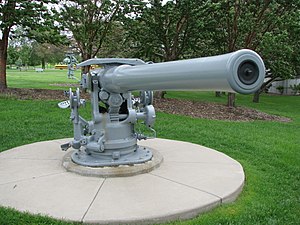4-inch/50-caliber gun: Difference between revisions
m undone authors list change |
m →References: cs1|2 maint: multiple authors/editors fixes; using AWB |
||
| Line 81: | Line 81: | ||
* {{Cite book| title=Naval Ordnance |author =Fairfield, A.P. |publisher=The Lord Baltimore Press |year=1921}} |
* {{Cite book| title=Naval Ordnance |author =Fairfield, A.P. |publisher=The Lord Baltimore Press |year=1921}} |
||
* Gardiner, Robert and Gray, Randal, ''Conway's All the World's Fighting Ships 1906-1921'' Conway Maritime Press, 1985. ISBN 0-85177-245-5. |
* Gardiner, Robert and Gray, Randal, ''Conway's All the World's Fighting Ships 1906-1921'' Conway Maritime Press, 1985. ISBN 0-85177-245-5. |
||
* {{Cite book| title=British and Dominion Warships of World War II | |
* {{Cite book| title=British and Dominion Warships of World War II |author1=Lenton, H.T. |author2=Colledge, J.J. |publisher=Doubleday and Company |year=1968}} |
||
{{Refend}} |
{{Refend}} |
||
Revision as of 23:27, 18 May 2016
| 4"/50 caliber naval gun | |
|---|---|
 The gun from USS Ward which fired the first American shot of World War II at Pearl Harbor on 7 December 1941 | |
| Type | Naval gun |
| Service history | |
| In service | 1913 - 1945 |
| Used by | |
| Wars | World War I, World War II |
| Production history | |
| Designed | 1910 |
| Variants | Mk 7, 8, 9 and 10 |
| Specifications | |
| Mass | 5,450 pounds (2,470 kg) |
| Length | 206.5 inches (5.25 m) |
| Barrel length | 200 inches (5 m) bore (50 calibres) |
| Shell | 33 pounds (15 kg)[1] |
| Calibre | 4 inches (100 mm) |
| Elevation | -15 to 20 degrees |
| Traverse | -150 to 150 degrees |
| Rate of fire | 8-9 rpm |
| Muzzle velocity | 2,900 feet per second (880 m/s)[1] |
| Maximum firing range | 15,920 yards (14,560 m)[1] |
The 4"/50 caliber Mark 9 gun (spoken "four-inch-fifty-caliber") was the standard low-angle, quick-firing gun for United States destroyers through World War I and the 1920s. It was also the standard deck gun on S-class submarines, and was used to rearm numerous submarines built with 3" guns early in World War II. United States naval gun terminology indicates the gun fired a projectile 4 inches (10 cm) in diameter, and the barrel was 50 calibers long (barrel length is 4 inch x 50 = 200 inches or 5 meters).[2]
Description
The built-up gun with a tube, full-length jacket, and side swing Welin breech block with Smith-Asbury mechanism weighed about 2.7 tons. Fixed ammunition (case and projectile handled as a single assembled unit) with a 14.5-pound (6.6 kg) charge of smokeless powder gave a 33-pound (15 kg) projectile a velocity of 2,900 feet per second (880 m/s). Range was 9 miles (14 km) at the maximum elevation of 20 degrees. Useful life expectancy was 500 effective full charges (EFC) per barrel.[1]
Increasing awareness of the need for improved anti-aircraft protection encouraged mounting of dual purpose guns on destroyers beginning in the 1930s. The dual-purpose 5"/38 caliber gun became standard for United States destroyers constructed from the 1930s through World War II. United States destroyers built with 4"/50 caliber low-angle guns were rearmed with dual-purpose 3"/50 caliber guns. The 4"/50 caliber guns removed from destroyers were mounted on Defensively Equipped Merchant Ships of the British Merchant Navy and United States Merchant Marine like SS Stephen Hopkins.[1] As S-boats were transferred from combat patrols to training duties from mid-1942 through 1943, their 4-inch guns were removed and used to re-equip front-line submarines built with 3"/50 caliber guns.
The 4"/50 caliber gun was mounted on:
- Template:Sclass-s[3]
- Template:Sclass-s[3]
- Template:Sclass-s[3]
- Template:Sclass-s[3]
- Template:Sclass-s[4]
- Template:Sclass-s[4]
- Template:Sclass-s[4]
- United States S-class submarines[5]
- the first seven Template:Sclass-s[1]
- USS Dolphin (SS-169)[5]
- numerous rearmed submarines including USS Salmon (SS-182), USS Seadragon (SS-194), USS Gato (SS-212), USS Silversides (SS-236) and USS Robalo (SS-273)[1]
UK service
Many Mark 9 guns were supplied to the United Kingdom during World War II as part of Lend-lease, both individually and on naval and merchant ships.[6] Caldwell, Wickes, and Clemson-class destroyers transferred under the Destroyers for Bases Agreement became British and Canadian Template:Sclass2-s.[7]
See also
Weapons of comparable role, performance and era
- BL 4 inch naval gun Mk VII British equivalent
Notes
References
- Campbell, John (1985). Naval Weapons of World War Two. Naval Institute Press. ISBN 0-87021-459-4.
- Fahey, James C. (1939). The Ships and Aircraft of the U.S. Fleet, War Edition. Ships and Aircraft.
- Fairfield, A.P. (1921). Naval Ordnance. The Lord Baltimore Press.
- Gardiner, Robert and Gray, Randal, Conway's All the World's Fighting Ships 1906-1921 Conway Maritime Press, 1985. ISBN 0-85177-245-5.
- Lenton, H.T.; Colledge, J.J. (1968). British and Dominion Warships of World War II. Doubleday and Company.
External links
- DiGiulian, Tony, United States of America 4"/50 (10.2 cm) Marks 7, 8, 9 and 10 at Navweaps.com
